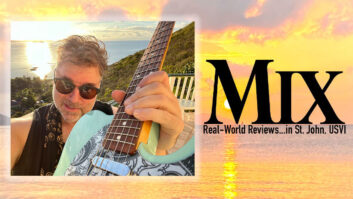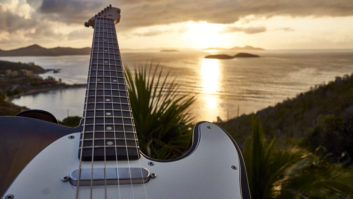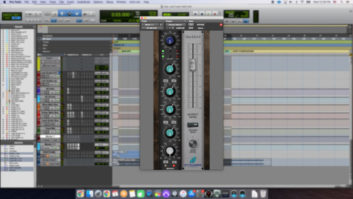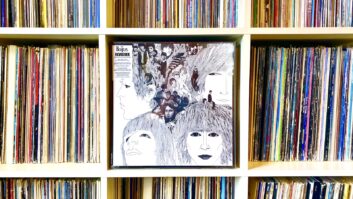Recording away from the comforts of my studio is never easy, especially when it’s a few thousand miles away from home on an island. However, with a lot of preparation, forethought, planning and help from FedEx, it can be a challenging, fun and ultimately rewarding adventure.
This year, a small gang of talented and crazy musicians, engineers and producers went to St John in the U.S. Virgin Islands for two weeks of playing shows, recording, composing and of course, relaxing. This is our third year touring down there and, luckily for us, bassist Hank Skalka has a big house cut into the side of the mountains.
Mountains, you say? Yes, St John is only 19 miles in diameter, accessible only by boat, and approximately 60 percent protected via its inclusion in the Virgin Islands National Park. St John’s terrain is quite rocky and hilly, with a variety of microclimates ranging from desert to lush forest, seemingly just feet from each other. Its beaches are pristine and, as I see it, it’s one of the most beautiful and inspirational places to be in the world—a great place to get away and work. I just need to take everything with me, as there are no music stores nearby.
I happen to play guitar in a side project called The Deep Dig, which consists of Scott E. Moore on vocals and acoustic guitar, Ray Levier on drums and Hank on bass. We play fun, twisted versions of the American songbook of funk and soul. But these guys also work quite a bit with me on all the TV cues that I compose, so we’re a multipurpose unit. Joining us were Clubhouse Studio owner/engineer Paul Antonell and assistant engineer/tech Mike Dwyer. We decided to turn the main room of the house into a rehearsal and recording spot, put one control room in Antonell’s room off to the side, and I would have a separate setup in the guest cottage. Both “studios” could work together and apart as needed.
The Gear
We had a small but powerful arsenal—some of which we knew, some of which we didn’t. A 16-channel snake in the live room fed a Grace m802 with the A/D card and m802RCU Remote Control Unit option ($5,225 plus $1,395 for remote). That in turn optically fed Antonell’s Universal Audio Apollo Twin ($699 SOLO, $899 DUO, street) with an Apollo Satellite for extra plug-in horsepower. In addition, two channels of XLR and quarter-inch DI preamp were available on the Twin for a total of 10 input channels (recording at 24 bit/48 kHz). The TRS outputs of the Twin also fed a pair of Fender Passport Studio portable powered studio monitors featuring a Focal driver set ($599 street). We ran the headphone out of the Twin back into the snake, into the live room and into a four-channel Behringer headphone preamp. Antonell was running Pro Tools 11 from his MacBook Pro with a bevy of plug-ins.
Ray Levier already had a Yamaha Manu Katche Signature Jr. drum set and cymbals at the house, which we captured with several DPA 4099D microphones on the toms, and DPA 2011 mics on snare and overheads. We also used a 2011 at different times on either the beater side or back side of the kick. For room/outside kick, we used an AEA N22 NUVO active ribbon mic. For the bass DI, we used the Acme Audio Wolfbox. On my Fender amp, I used a 4099D taped to the cabinet (fancy, huh?); Moore ran his Larivee acoustic split with a Baggs DI into the PA and also into a Fender amp, though he would overdub his parts (due to the limitation of input channels).
For rehearsals and live shows on the island, we had QSC K10 speakers and a workhorse Allen & Heath analog mixing board with built-in digital effects. Moore sang through either the Earthworks SR40V condenser ($999 street) or DPA d:facto II ($949 street), both of which sound bright and airy. The SR40V and d:facto II were great to have available because they were equally at home in the studio during the day and onstage at night. We did a direct comparison/test with those mics and a Shure Beta 58 “control” mic (which I like a lot); in comparison, the Beta 58 sounded like a sonic mask was hovering over the source. With both the Earthworks and DPA models, highs were crisp and the lows beefy, especially when getting right up close.
My room was in a separate two-story guest cottage off to the side of the main house. The setup was simple but efficient. I had my trusted NHT Pro M00 monitors and S00 subwoofer sent from home, so I already knew the sound of them. The speakers were sitting on a tabletop, but I put them on a set of IsoAcoustics ISO-L8R155 monitor stands ($99 street, per pair), which decoupled them and kept the imaging tight.
My MacBook Pro was running Pro Tools 10 and 11. A Universal Audio Apollo Twin hooked up via Thunderbolt to the laptop, and also via Thunderbolt to an external hard drive. A small M-Audio Axiom AIR Mini 32 ($99 street) handled keyboard duties as well as basic transport control, connected to the laptop via USB. For headphones, I used my Sony MDR-7520 headphones ($379 street), which I find are actually accurate enough to mix on (when not using my speakers).
Work/Play Environment
The plan of the trip was basically to do a handful of live shows (we had eight shows booked across two weeks), and some tracking in the live room of band tunes, rehearsals and additional personal projects. I was going to be working on some score-to-picture projects in my room while also composing TV cues there. While we were there, I literally got several different assignments that I was able to compose immediately—because in TV Land, one has to move fast. The main house had a satellite cable uplink, so I could transfer files via Hightail and FTP.
Since we had two rooms set up, I could bring the mix up to Studio A for any live drums, which I ended up recording on a few cuts. However, we also set up some drums, mics and percussion down in my room and recorded tracks there as well.
There are several lessons I quickly learned about recording away from home. One is that stepping out of my comfort zone causes changes, both good and bad. Sure—we were “comfortable” being in St John; I was just using different gear in a different place and things will “sound different.” Yet I adjusted quickly and used that to my advantage, creating tracks with a different feel and sound to them. Plus, using different gear than I’m used to can be fun, and that’s really how I learn their ins and outs, both literally and figuratively. It’s also lot of fun to get a portable studio up and running; when we arrived, we set up both studios before we even unpacked. We were laughing about it later, after looking up at the view and reminding ourselves where we were!
One of the first things Antonell did was play back a bunch of music he was familiar with on those Fender/Focal monitors, both to adjust to the monitors and the room itself. I’d worked down in my room for several years prior, so I already knew its sound. Also, I was already comfortable with my NHT Pro monitors from home. The live room at the house had very high ceilings and a lot of tile, so next we scoured the house and found some lounge chair pads, which we placed behind the drums in the corner. Also, we took parts of the couches and turned them on their sides around the kit, making a small padded iso setup. It certainly didn’t alleviate the ambient room, but did make for a tighter area around the kick, etc. In this scenario, you make the best with what you’ve got!
Sitting there in St John, I was reminded that composing with this view is inspirational. As I mentioned, the gear is different, and much more limited than if I was at home. But that meant I called up different plug-in instruments for composition. Looking out the window at the blue sea definitely makes me happy, and therefore the tracks I was composing naturally had a lighter feel to them. One of the projects I received during the week was for some “comedy” tracks for The History Channel’s Pawn Stars, so I wrote some cool, happy tracks and had the boys come down to my cottage and play on them as well. Mike Dwyer engineered the session and did a great job—kudos to him.
Another assignment I received while I was there was for a sports show on NBC, which called for some dark, ambient moments. I composed that stuff at night since the light was different; I even took some of those tracks up to the other studio for drum overdubs in the live room. I also got one mix-to-picture video project while there, and I downloaded the files, imported the video (.mov file) and the .aaf. Everything synced up perfectly; I mixed their project and simply uploaded a finished stereo track to them via satellite cable. Easy-breezy!
More Gear Details
I’ve used Grace preamps and monitor controllers for years, but never used the m802 with the RCU. Once unpacked, with the remote unit set up, I had to figure out how to sync it with the UAD, since I was running it optically. After figuring that out on the remote (and more on that process in the sidebar), I had eight pristine channels of Grace Design pre-amplification with full control right next to the mix position.
As expected, the Grace preamp lived up to its reputation. The sound is clean, clear and uncolored; it worked especially well with the DPA and AEA microphones. Also, having a remote next to the mix position is a great way to work; I just had to get used to scrolling through the parameters for settings. That only took a short time, and the m802 turned out be the “gear star” of the trip.
The DPA microphones were an extension of working from home. I already use 4099Ds on toms and 2011Cs for overheads, but now I had a 2011A pair to work with as well, and a d:facto II vocal mic. The 2011A, with its 20 Hz-20 kHz response has a longer body (a different preamp than the 2011C) and seemingly a bit more low-end. Both the A and C models are crystal clear, with excellent rejection, which is why I use them for overheads at home. They make great mics for percussion, acoustic guitar and even vocals—although we had the excellent d:facto II vocal mic, which is like a Shure Beta 58 on steroids.
Another incredible application for the DPA 2011A is on snare/hi-hat combo, where the mic is placed about 3 feet above them, pointing down. It’s a pure, natural and powerful sound, especially when combined with the clarity of the Grace Design preamp. Between the DPAs and the AEA N22 NUVO, the kit sounded great. We used the room’s inherent ambience to our advantage, going for live and almost Zeppelin-like drums. Scott E. Moore also worked with Antonell recording some of his acoustic/vocal numbers, using the AEA for voice and a 2011C for guitar.
Having never heard the Fender Passport Studio portable studio monitors, I was not sure what was in store for us, but they were immediately a pleasant surprise. Focal made the drivers—a five-inch poly-glass cone woofer and aluminum/magnesium inverted-dome tweeter. They are front-ported enclosures with Stereo eighth-inch aux input and Stereo eighth-inch headphone output as well as switchable bass and treble room correction controls (+, 0, -). The rear opens up for cable storage on the right speaker, and TRS L/R inputs on the left (which connects to the right via separate TRS). The cabinets actually connect to each other for transport, becoming a cool, compact, robust and portable package. Most importantly, they sound quite nice. They also turned out to be great speakers to play back music when just hanging out on the deck at night, offering a multipurpose usefulness. In fact, Antonell took them home after the trip and won’t give them back.
Summary
This year’s St. John sessions were a blast. We had a handful of fun live shows and completed a bunch of tracks in our combined studios. We got to try out new gear, make new sounds and learn a thing or two. The same gang will be going again next year, and I can’t wait to see what gear we’ll be traveling with then.







